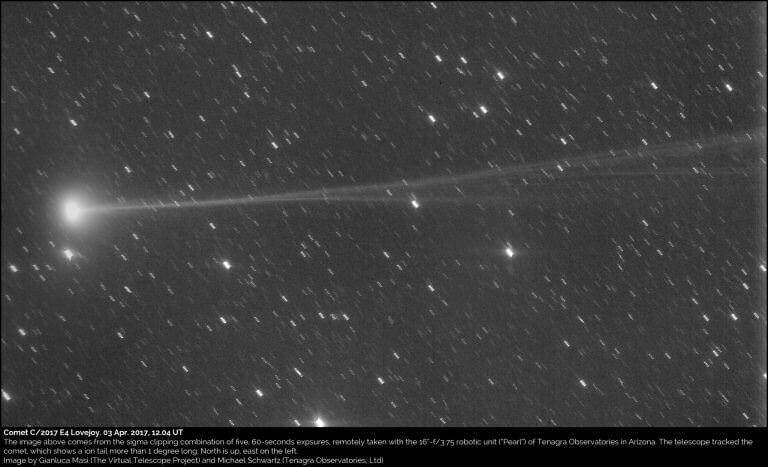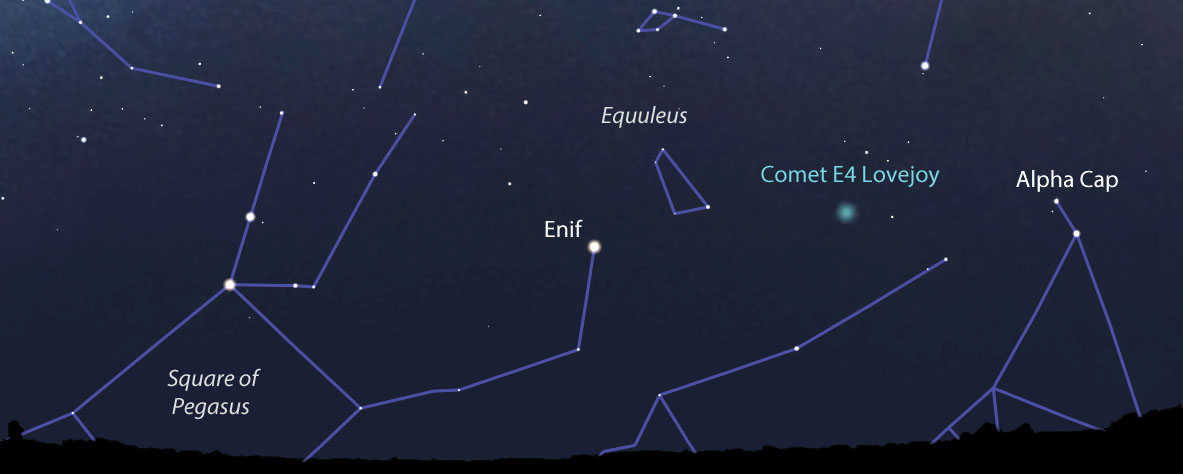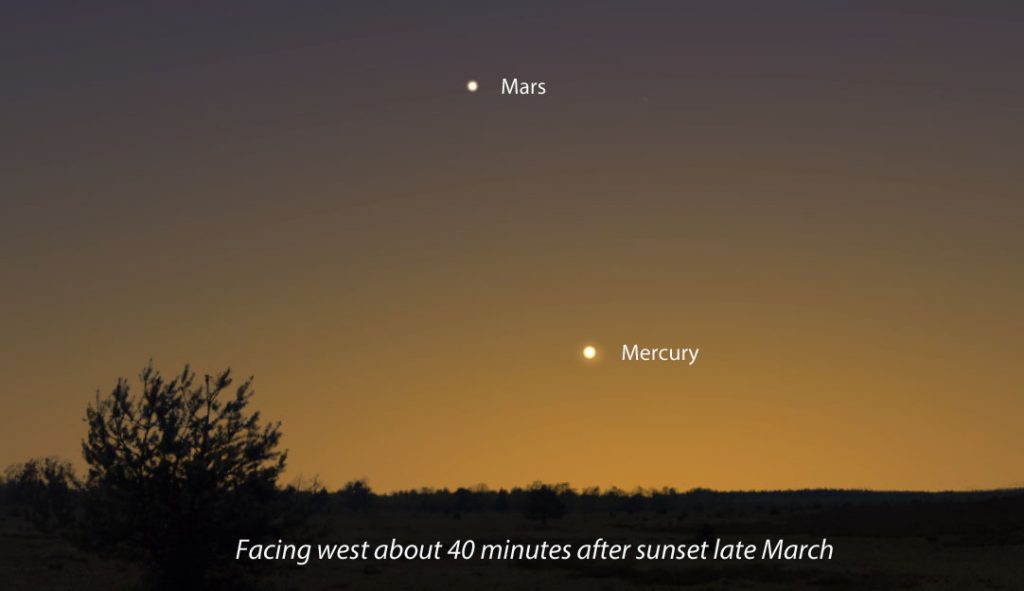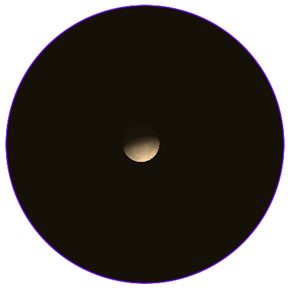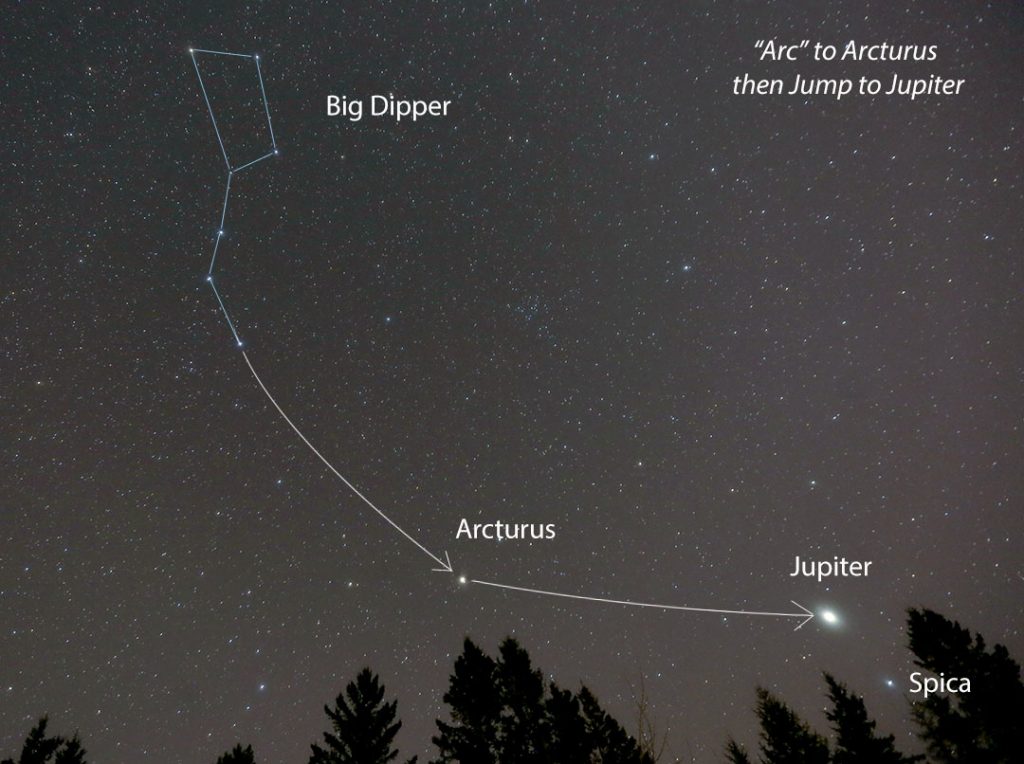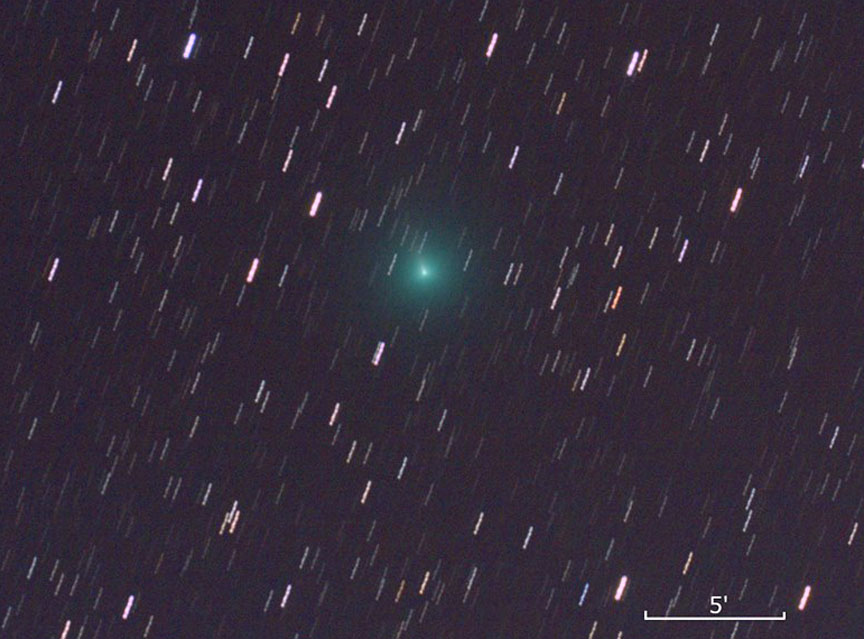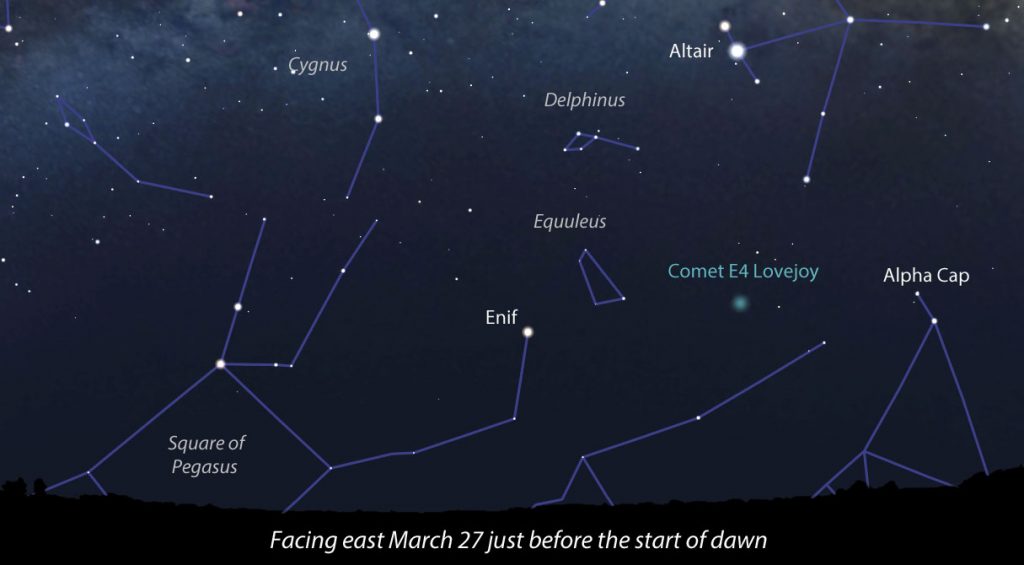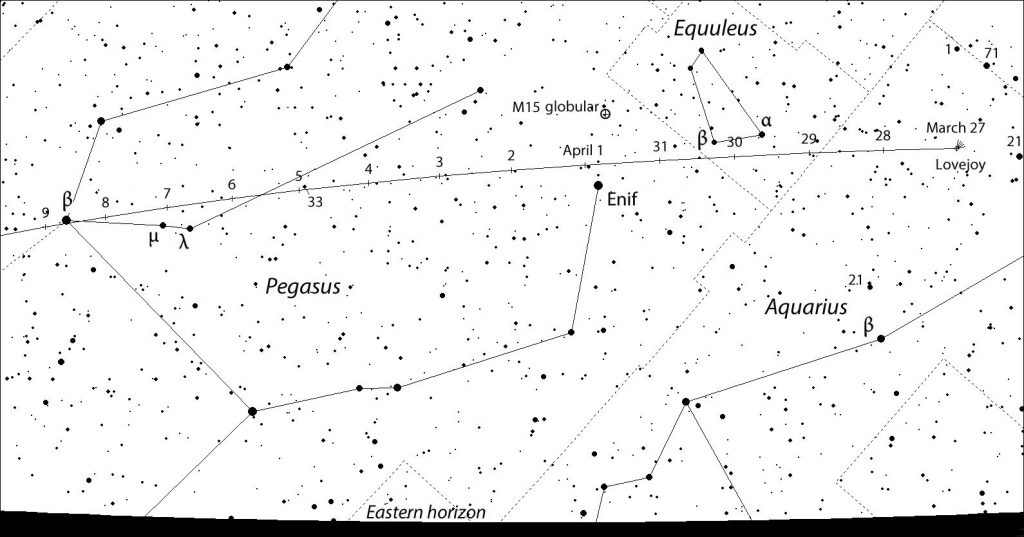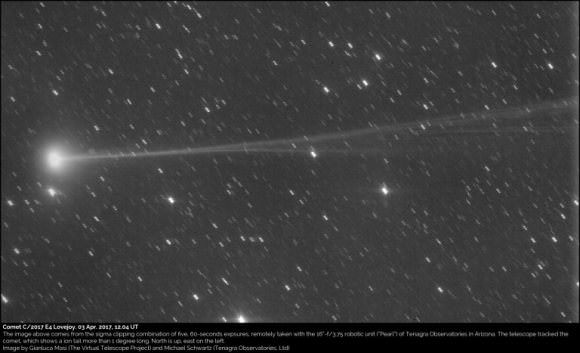
Had your fill of binocular comets yet? Thus far this year, we’ve had periodic comets 2P/Encke, 45P/Honda-Mrkos-Pajdušáková and 41P/Tuttle-Giacobini-Kresák all reach binocular visibility above +10th magnitude as forecasted. Now, we’d like to point out a surprise interloper in the dawn sky that you’re perhaps not watching, but should be: Comet C/2017 E4 Lovejoy.
If that name sounds familiar, that’s because E4 Lovejoy is the sixth discovery by prolific comet hunter Terry Lovejoy. Comets that have shared the Lovejoy moniker include the brilliant sungrazer C/2011 W3 Lovejoy, which amazed everyone by surviving its 140,000 kilometer (that’s about 1/3 the Earth-Moon distance!) pass near the blazing surface of the Sun on December 16th, 2011 and went on to be a great comet for southern hemisphere skies.
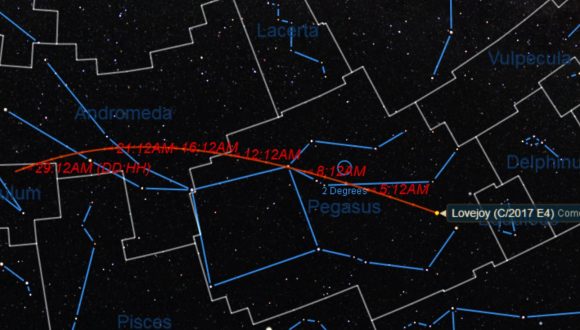
Unfortunately, E4 Lovejoy won’t get quite that bright, but it’s definitely an over achiever. Shining at a faint +15th magnitude when it was first discovered last month on March 9th, 2017, it has since jumped up to +7th magnitude (almost 160 times in brightness) in just a few short weeks. We easily picked it out near the +2.4 magnitude star Enif (Epsilon Pegasi) on Saturday morning April 1st in the pre-dawn sky. E4 Lovejoy was an easy catch with our Canon 15×45 image-stabilized binocs, and looked like a tiny +7 magnitude globular (similar to nearby Messier 15) that stubbornly refused to snap into focus. In fact, I’d say that E4 Lovejoy was a much easier comet to observe than faint Comet 41P/Tuttle-Giacobini-Kresák, which made its closest pass 0.142 Astronomical Units (21.2 million kilometers) from the Earth on the same day.
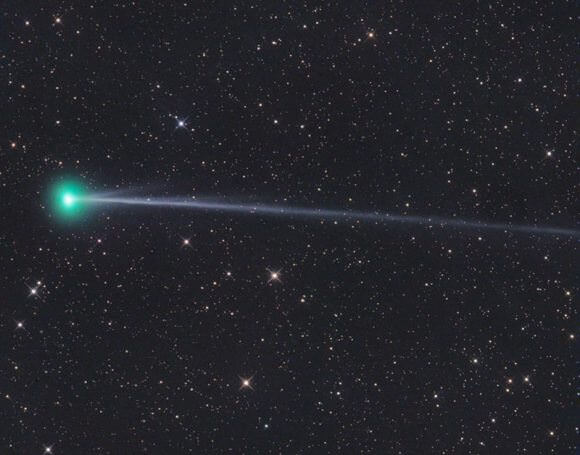
Prospects and Prognostications
E4 Lovejoy will remain an early pre-dawn object through April for northern hemisphere observers as it glides through the constellations Pegasus, Andromeda and Triangulum. If current predictions hold true, the comet should reach a maximum brightness of magnitude +6 around April 15th. On an estimated ~ 600,000 year orbit, Comet E4 Lovejoy may be a first time visitor to the inner solar system, and its current outburst may also be short-lived. In fact, there’s lots of speculation that Comet E4 Lovejoy may disintegrate altogether, very soon. Plus, the Moon is headed towards Full next week on April 11th, making this week the best time to catch a glimpse of this fleeting comet.
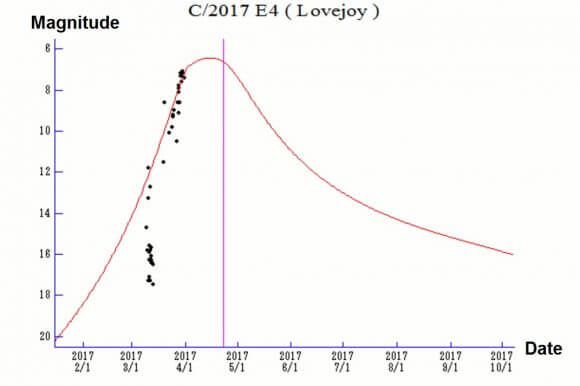
And to think: we just missed having a bright naked eye comet! That’s because Comet E4 Lovejoy very nearly passed through the space that the Earth will occupy just next month. In fact, the comet passed just 0.11 AU (17 million kilometers) interior to the Earth’s orbit on March 22nd, 2017. Had it done the same on May 4th, it would have been 5 times closer and 25 (about 3 to 4 magnitudes) times brighter!
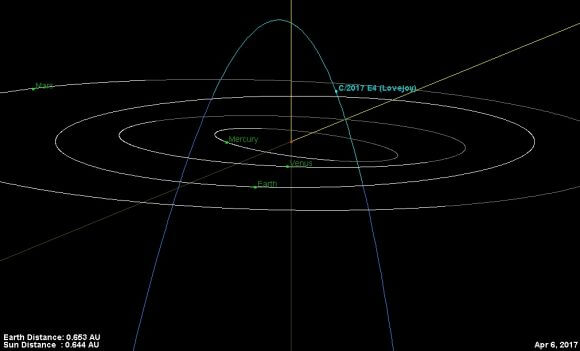
A tantalizing miss, for sure. Comet C/2017 E4 Lovejoy reaches perihelion at 0.5 AU (77.5 million kilometers) from the Sun on April 23rd, and passed 0.6 AU (93 million kilometers) from the Earth on March 31st. This week, it will be moving through Pegasus at a rate of about four degrees (8 Full Moon diameters) a day. With an orbital inclination of 88 degrees, Comet E4 Lovejoy’s path is very nearly perpendicular to the ecliptic path traced out by the Earth. The comet swung up from the south during discovery, and is now headed northward towards perihelion.
Here are some key dates for Comet C/2017 E4 Lovejoy to watch out for in April:
April 7th: Passes less than one degree from the +3.5 magnitude star Sadal Bari (Lambda Pegasi).
April 9th: Passes less than 10′ from the +2.4 magnitude star Scheat (Beta Pegasi).
April 13th: Crosses into the constellation Andromeda.
April 19th: Photo-op, as the comet passes 4 degrees from the Andromeda Galaxy M31.
April 22nd: Passes between the +2nd magnitude star Mirach and the +4th magnitude star Mu Andromedae.
April 27th: Passes five degrees from the Pinwheel Galaxy M33.
April 28th: Crosses into the constellation Triangulum.
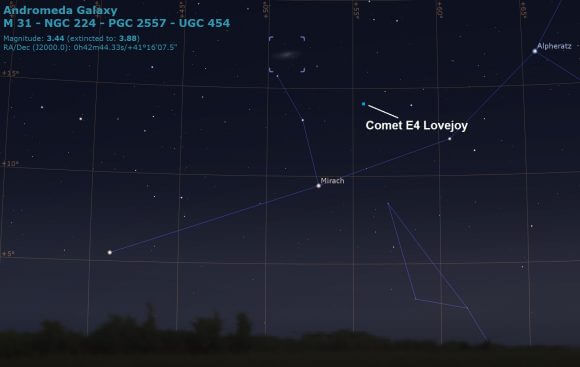
Teaser for 2017 Comets
We’re barely a quarter of the way through 2017, with more cometary action to come. We’re expecting 2015 ER51 PanSTARRS (May), and 2015 V2 Johnson (June) to reach binocular visibility. You can read about comets, occultations, and more in our guide to 101 Astronomical Events for 2017, a free e-book from Universe Today.
We’re due for the next big one, for sure. It always seems like there’s a “Great Comet” per every generation or so, and its been 20 years now since comets Hale-Bopp and Hyakutake graced northern skies.
Binoculars are the best tool for observing comets like E4 Lovejoy, as they offer a generous true (i.e. not inverted) field of view. A good finder chart and dark skies also help. We like to find a good nearby ‘anchor’ object such as a bright star, then hop into the suspected comet area and start sweeping.
One thing’s for sure: we need more comets with names like Lovejoy… if nothing else, it’s much easier to pronounce, and us science writers don’t have to keep hunting through the ‘insert’ menu for those strange letter symbols that grace many of these icy denizens of the Oort Cloud as they pay a visit to the inner solar system.

